The Botulism Market is estimated to be valued at USD 8.9 billion in 2025 and is projected to reach USD 17.0 billion by 2035, registering a compound annual growth rate (CAGR) of 6.7% over the forecast period.
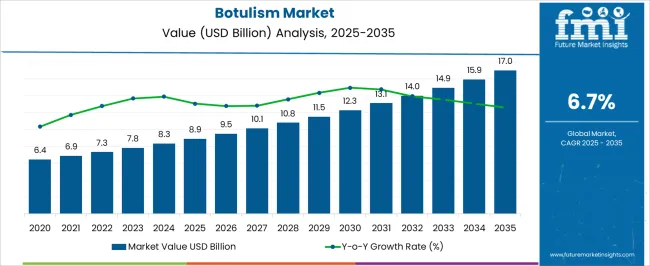
| Metric | Value |
|---|---|
| Botulism Market Estimated Value in (2025 E) | USD 8.9 billion |
| Botulism Market Forecast Value in (2035 F) | USD 17.0 billion |
| Forecast CAGR (2025 to 2035) | 6.7% |
The botulism market is witnessing stable growth, driven by the rising incidence of rare but severe cases of botulinum toxin exposure and the increasing focus on preparedness against potential biological threats. The demand for antitoxins is being supported by government stockpiling programs, emergency response initiatives, and improved awareness of foodborne and wound-related infections. Advancements in medical research and greater access to life-saving therapies are reinforcing market expansion, particularly in regions with strong healthcare infrastructure.
Growing collaborations between pharmaceutical companies and public health organizations are ensuring the availability of reliable treatment options during outbreaks. Regulatory bodies are also prioritizing the approval and distribution of antitoxins to strengthen emergency preparedness.
Increasing funding in rare disease research and the continued development of advanced formulations with broader strain coverage are shaping the future outlook of the market With heightened emphasis on rapid response, improved diagnostic capabilities, and reliable distribution channels, the botulism market is expected to maintain steady growth, ensuring readiness against both natural and accidental cases of infection.
The botulism market is segmented by drug type, distribution channel, and geographic regions. By drug type, botulism market is divided into Heptavalent Botulinium Antitoxin, Antitoxin, Trivalent Antitoxin, and Antibiotics. In terms of distribution channel, botulism market is classified into Hospitals including hospital pharmacies, Clinics, and Retail pharmacies. Regionally, the botulism industry is classified into North America, Latin America, Western Europe, Eastern Europe, Balkan & Baltic Countries, Russia & Belarus, Central Asia, East Asia, South Asia & Pacific, and the Middle East & Africa.
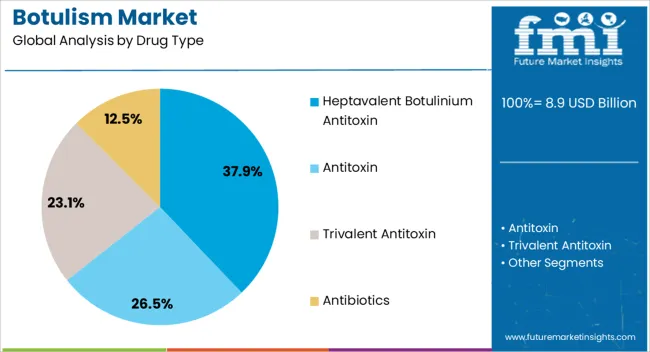
The heptavalent botulinium antitoxin drug type segment is projected to account for 37.9% of the botulism market revenue share in 2025, making it the leading therapeutic option. Its leadership is being supported by its ability to neutralize multiple serotypes of botulinum toxin, thereby providing broader clinical coverage compared to other treatment alternatives.
The effectiveness of this antitoxin in reducing disease progression and preventing complications has strengthened its adoption as the first-line therapeutic solution in emergency medical settings. Rising government investments in national stockpiles and preparedness programs have further reinforced demand for the heptavalent formulation, as it addresses the need for comprehensive protection against diverse toxin strains.
The segment’s growth is also being enhanced by increased awareness among healthcare providers regarding the importance of timely administration to improve survival rates Continued advancements in biologics manufacturing and improvements in antitoxin availability are expected to support the sustained dominance of the heptavalent botulinium antitoxin segment within the global botulism market.
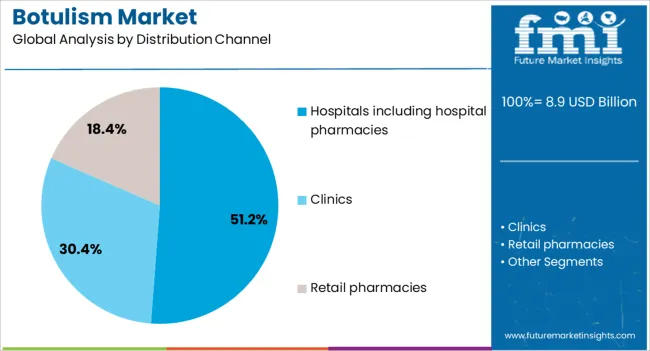
The hospitals including hospital pharmacies distribution channel segment is anticipated to hold 51.2% of the botulism market revenue share in 2025, positioning it as the dominant distribution channel. This dominance is being driven by the critical need for rapid access to life-saving treatments in controlled clinical environments. Hospitals serve as the primary point of care for patients suffering from botulism, where immediate diagnosis and treatment are essential to reduce mortality risks.
The availability of specialized facilities and trained medical staff in hospital settings ensures proper administration of antitoxins and effective patient management. Hospital pharmacies play a central role in ensuring consistent supply, regulated storage conditions, and timely distribution of biologics to clinical departments.
Increasing government and institutional support for strengthening hospital-based preparedness programs is further fueling demand in this channel As awareness and diagnostic capabilities continue to expand, hospitals and their associated pharmacies are expected to remain the key access point for botulism treatment, reinforcing their dominant position in the global market.
The rising cases of food and wound contamination are fueling the rising cases of botulism among people. Botulism is a serious illness caused by toxins along with wound infections. The bacteria behind the spread of the disease are known as clostridium botulism. The demand for more information about the disease, its symptoms, and its cure is fueling the growth of the botulism market.
Increased R&D programs funded by governments coupled with the strong efforts by CDC and WHO are pushing authorities to spread awareness around it. The botulism market is thriving due to these high-end research programs that deliver antitoxin for preventing the damage done by the bacteria.
The major factors that drive the growth of the botulism market include an increase in R&D practices, availability of efficient solutions for botulism, lack of hygiene in certain regions of the world, and increase in awareness about disease and treatments.
Different types of botulism involve food-borne botulism, infant botulism, wound botulism, latrogenic botulism, and adult intestinal toxemia botulism. The rising demand for botulism-specific antitoxins has fueled the demand for botulism treatment products.
Wound botulism, being the most common type, demands extra care as the wound needs to be healed along with detoxing the bacteria. While a damaged digestive system also triggers the chances of getting adult intestinal toxemia botulism. The geriatric population and the modern eating habits that revolve around packaged and canned food items are also the major driving factors for the botulism market.
Botulism is a rare but serious fatal paralytic disorder, caused by neurotoxins produced by a bacteria Clostridium botulinum. The symptoms of botulism are classified under foodborne botulism, wound botulism and infant botulism. some common symptoms include weakness, paralysis, vision,swallowing, breathing and speaking problems.
The weakness further leads to fatigue of limb muscles. The symptoms are not caused by the bacterium itself, but by the toxin produced by the bacterium. Children with less than 6 months of age are primarily attacked by this bacteria and may also occur to children with poor immune system.
The bacteria may enter the body through wounds, or by eating them from improperly canned or preserved food.
Patients who survive an episode of botulism poisoning may experience fatigue and shortness of breadth for years and long-term theray may be needed to aid recovery.
There are many factors that directly cause botulism as an effect, such as contact with soil and dust in babies while a wound gets infected from the clostridium botulism bacteria as it gets introduced into the bloodstream.
The unknown eating factors that develop this bacterium and enter the human body can be explained as follows:
These unknown food habits can lead to the botulism while the treatment involves antitoxins that flushes out the toxins damaging your organs and skin. In some severe cases, doctors also prescribe hospitalization for months.
The major factors that drives growth of botulism market includes, increase in R&D practices, availability of efficient solutions for botulism, lack of hygienity in certain region of the world and increase in the awareness about disease and treatments.
In addition, owing to strong efforts by WHO and CDC, the disease is getting irradiated slowly.However, high cost of R&D and government austerity are some of the hurdles expected to hinder the growth of botulism market.
Botulism is generally treated with antitoxin and supportive care. Supportive care for botulism includes monitoring of respiratory function. Antitoxin is required in case of both foodborne and wound botulism. Wounds should be treated, usually surgically, to remove the source of the toxin-producing bacteria followd by administration of appropriate antibiotics.
Mechanical ventilators are needed when there is a breathing problem while rehabilitation therapies are needed in case of speaking or swallowing problem. Health care providersmust tell state health authorities or the USA Centers for Disease Control and Prevention (CDC) about patients with botulism, so that the contaminated food can be removed from stores.
Infants are more prone to unhygienic or contaminated food and hence, they are more prone to this disease.
Region wise, the global botulism marketis classified into regions namely, North America, Latin America, Western Europe, Eastern Europe, Asia-Pacific, Japan, Middle East and Africa.The North American region is the most prominent market, followed by Europe. According to CDC, in the USA, an average of 145 cases are reported each year. Of these, approximately 15% are foodborne, 65% are infant botulism and 20% are wound. However, Asia-Pacific region is the most promising market for the forecast period.
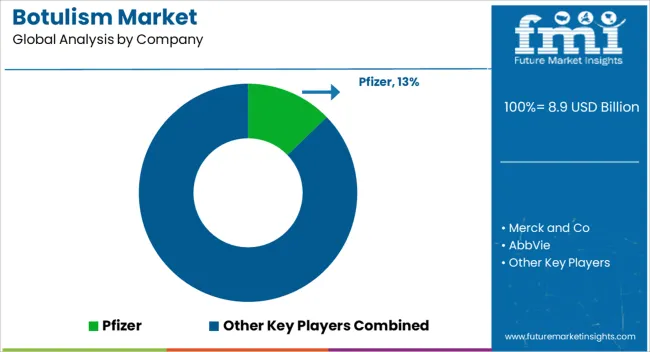
The major players operating in botulism market includes XOMA Corporation, AlphaVax, Inc., Microbiotix, Inc., Molecular Targeting Technologies, Inc., and Morphotek, Inc. amongst others.
The report is a compilation of first-hand information, qualitative and quantitative assessment by industry analysts, inputs from industry experts and industry participants across the value chain. The report provides in-depth analysis of parent market trends, macro-economic indicators and governing factors along with market attractiveness as per segments. The report also maps the qualitative impact of various market factors on market segments and geographies.
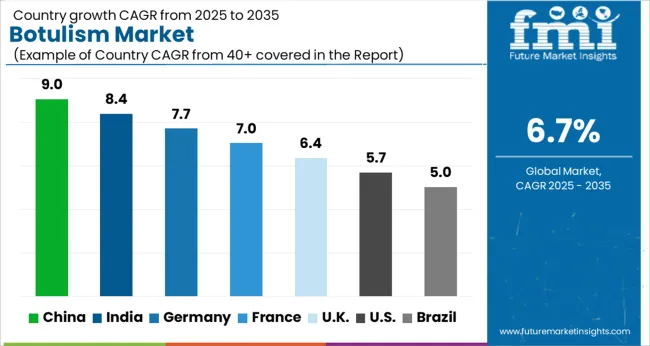
| Country | CAGR |
|---|---|
| China | 9.0% |
| India | 8.4% |
| Germany | 7.7% |
| France | 7.0% |
| UK | 6.4% |
| USA | 5.7% |
| Brazil | 5.0% |
The Botulism Market is expected to register a CAGR of 6.7% during the forecast period, exhibiting varied country level momentum. China leads with the highest CAGR of 9.0%, followed by India at 8.4%. Developed markets such as Germany, France, and the UK continue to expand steadily, while the USA is likely to grow at consistent rates. Brazil posts the lowest CAGR at 5.0%, yet still underscores a broadly positive trajectory for the global Botulism Market. In 2024, Germany held a dominant revenue in the Western Europe market and is expected to grow with a CAGR of 7.7%. The USA Botulism Market is estimated to be valued at USD 3.3 billion in 2025 and is anticipated to reach a valuation of USD 5.7 billion by 2035. Sales are projected to rise at a CAGR of 5.7% over the forecast period between 2025 and 2035. While Japan and South Korea markets are estimated to be valued at USD 447.5 million and USD 274.1 million respectively in 2025.
| Item | Value |
|---|---|
| Quantitative Units | USD 8.9 Billion |
| Drug Type | Heptavalent Botulinium Antitoxin, Antitoxin, Trivalent Antitoxin, and Antibiotics |
| Distribution Channel | Hospitals including hospital pharmacies, Clinics, and Retail pharmacies |
| Regions Covered | North America, Europe, Asia-Pacific, Latin America, Middle East & Africa |
| Country Covered | United States, Canada, Germany, France, United Kingdom, China, Japan, India, Brazil, South Africa |
| Key Companies Profiled | Pfizer, Merck and Co, AbbVie, Johnson and Johnson, GSK, Boehringer Ingelheim, Acadia Pharmaceuticals, Teva Pharmaceutical Industries, Novartis, Regeneron Pharmaceuticals, BristolMyers Squibb, AstraZeneca, Amgen, Eli Lilly and Company, and Sanofi |
The global botulism market is estimated to be valued at USD 8.9 billion in 2025.
The market size for the botulism market is projected to reach USD 17.0 billion by 2035.
The botulism market is expected to grow at a 6.7% CAGR between 2025 and 2035.
The key product types in botulism market are heptavalent botulinium antitoxin, antitoxin, trivalent antitoxin and antibiotics.
In terms of distribution channel, hospitals including hospital pharmacies segment to command 51.2% share in the botulism market in 2025.






Full Research Suite comprises of:
Market outlook & trends analysis
Interviews & case studies
Strategic recommendations
Vendor profiles & capabilities analysis
5-year forecasts
8 regions and 60+ country-level data splits
Market segment data splits
12 months of continuous data updates
DELIVERED AS:
PDF EXCEL ONLINE

Thank you!
You will receive an email from our Business Development Manager. Please be sure to check your SPAM/JUNK folder too.
Chat With
MaRIA